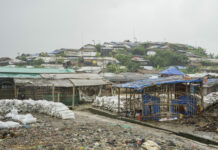Is there any point in sharing the image of the little boy who drowned in the Mediterranean, after his parents made a perilous bid to enter Europe? ATHER ZIA says that if we are to pay tribute to him, we must share his picture, not censor it.
Since yesterday, my social media newsfeed has been replete with images of the tiny lifeless body of Aylan Kurdi, the three-year-old Syrian boy who washed ashore on a Turkish beach.
After being refused asylum by the Canadian government, Aylan’s family was headed to the tiny Greek island of Kos with other refugees when the boat capsized. Aylan drowned, along with his mother and his five-year-old brother.
‘My children slipped through my hands’: Syrian father of drowned boy http://t.co/IHmn2cdXTa pic.twitter.com/QGC9bTMBvR
— Times LIVE (@TimesLIVE) September 3, 2015
On one hand, Aylan’s picture has brought many disparate but well-meaning voices together to rally support for Syrian refugees. Whether it will yield fruit remains to be seen. On the other hand, many people are enraged about the social media proliferation of Aylan’s image. One voice opined, “Would you share the picture of a dead body of your own child?”, another one roared in caps lock, “Show some sensitivity.†Yet another descended into a longwinded, oft-repeated spiel about violent images in popular culture and our mass desensitisation, reminiscent of syllabi for a media 101 class.
I agree that all is fair in the arena of personal opinions and that images can do violence to the dead and the living. I also acknowledge being a mother, which makes me as vulnerable as any parent when thinking about a child suffering. Aylan’s picture could be my boy when he was a toddler – sleeping on his tummy or dead at an idyllic beach. If my boy were to drown due to personal negligence or some other quirk of nature, I would not post his picture since my grief would be private.
On the other hand, if my child were to drown while seeking asylum and denied safe haven everywhere, I would choose to show his predicament. Especially in the face of powers that want these depictions suppressed to thwart support for refugees and ending wars. Aylan’s picture is not a saga of personal privations. His death is a political murder, which has been masked as drowning, and his quest for safety has been branded as migration. The words “illegal†and “illegitimate†have been prefixed to his status, and those of his countrymen. In that context, Aylan’s last image on earth is an icon of global apathy; the effect on our finer sensitivities and questions about the ethics of using these images should be of the least concern at this moment. ________________________________________________________________________________ RELATED: Part I: The Western world is not the only one ignoring events in Yemen ________________________________________________________________________________ For people raising issues on sharing Aylan’s picture, who spew arguments of ill-placed ethical worth around images, know this: Aylan is now a political symbol. Banning his picture on social media and supporting censorship only exposes how bourgeoisie narratives of what constitutes violence and respect have been ingrained into all of us. We must ask ourselves, what is the real tribute to Aylan – telling his story, even if through a picture, or suppressing it? Even though Aylan’s little light flickered and went out too soon, his death must not go to waste. His picture, though heartbreaking, is a legacy which needs to be made visible. A picture is a worth a thousand words, goes the old saying.
One of most shared pictures of Aylan Kurdi & brother who died trying to reach Greece http://t.co/qINKW7zcpg pic.twitter.com/vCHNK16hkD — BBC News (World) (@BBCWorld) September 3, 2015
The gaze of the middle-class behind the computer monitors often buys into the bourgeoisie-ordained politically correct versions of which violence to show and which to ignore. This has become a handy prop to propagate unjust politics.
Remember Abu Ghraib? Until the pictures of the torture and abuse of prisoners there seeped into the American and global consciousness, it was just another organic event in the “liberation” of undemocratic savages.
In context of sharing images of death and deprivation, sometimes we have to change our politically correct behaviours to contribute to change, even if we are still behind our monitors.
An old anthropology professor once said that everyone stands naked at some point during the day; insanity manifests in whether we choose to do it in public or in private.
In the mayhem of unjustified wars fueled by the rampant consumerism of the privileged nations, our display of an innocent child’s dead body is abhorrent. But with all due respect to anthropological truisms, in order to stay sane, we sometimes have to go naked in public.
 Ather Zia is a journalist turned anthropologist. She is a poet, writer and faculty member at the University of Northern Colorado. She is the founder and editor of the Kashmiri literary magazine, Kashmir Lit.
Ather Zia is a journalist turned anthropologist. She is a poet, writer and faculty member at the University of Northern Colorado. She is the founder and editor of the Kashmiri literary magazine, Kashmir Lit.
– Featured image: via Twitter.

![Genderme carries Aylan Kurdi from the beach [via TimesLive on Twitter]](https://www.thedailyvox.co.za/wp-content/uploads/2015/09/Genderme-carries-Aylan-Kurdi-from-the-beach-via-TimesLive-on-Twitter.jpg)








